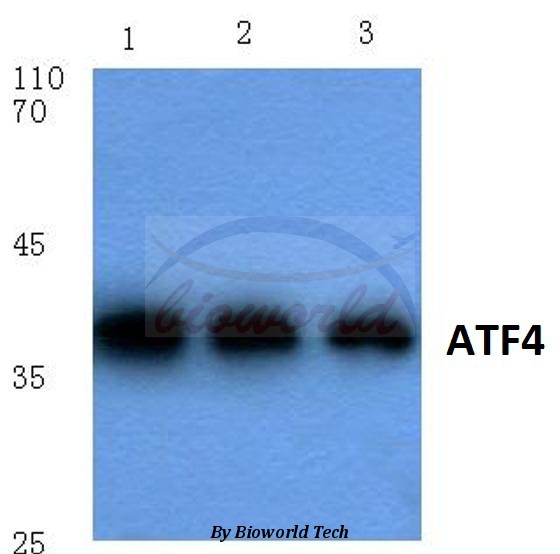ATF4 antibody
GTX101943
ApplicationsImmunoFluorescence, Western Blot, ImmunoCytoChemistry
Product group Antibodies
TargetATF4
Overview
- SupplierGeneTex
- Product NameATF4 antibody
- Delivery Days Customer9
- Application Supplier NoteWB: 1:500-1:3000. ICC/IF: 1:100-1:1000. *Optimal dilutions/concentrations should be determined by the researcher.Not tested in other applications.
- ApplicationsImmunoFluorescence, Western Blot, ImmunoCytoChemistry
- CertificationResearch Use Only
- ClonalityPolyclonal
- Concentration1.7 mg/ml
- ConjugateUnconjugated
- Gene ID468
- Target nameATF4
- Target descriptionactivating transcription factor 4
- Target synonymsCREB-2, CREB2, TAXREB67, TXREB, cyclic AMP-dependent transcription factor ATF-4, DNA-binding protein TAXREB67, cAMP response element-binding protein 2, cAMP-dependent transcription factor ATF-4, cAMP-responsive element-binding protein 2, cyclic AMP-responsive element-binding protein 2, tax-responsive enhancer element B67, tax-responsive enhancer element-binding protein 67
- HostRabbit
- IsotypeIgG
- Protein IDP18848
- Protein NameCyclic AMP-dependent transcription factor ATF-4
- Scientific DescriptionThis gene encodes a transcription factor that was originally identified as a widely expressed mammalian DNA binding protein that could bind a tax-responsive enhancer element in the LTR of HTLV-1. The encoded protein was also isolated and characterized as the cAMP-response element binding protein 2 (CREB-2). The protein encoded by this gene belongs to a family of DNA-binding proteins that includes the AP-1 family of transcription factors, cAMP-response element binding proteins (CREBs) and CREB-like proteins. These transcription factors share a leucine zipper region that is involved in protein-protein interactions, located C-terminal to a stretch of basic amino acids that functions as a DNA binding domain. Two alternative transcripts encoding the same protein have been described. Two pseudogenes are located on the X chromsome at q28 in a region containing a large inverted duplication. [provided by RefSeq]
- Storage Instruction-20°C or -80°C,2°C to 8°C
- UNSPSC12352203
References
- Held A, Lapka J, Sargeant J, et al. Steady-state regulation of COPII-dependent secretory cargo sorting by inositol trisphosphate receptors, calcium, and penta EF hand proteins. J Biol Chem. 2023,299(12):105471. doi: 10.1016/j.jbc.2023.105471Read this paper
- Leu JG, Wang CM, Chen CY, et al. The Cell Protective Effect of Adenine on Hypoxia-Reoxygenation Injury through PPAR Delta Activation. Life (Basel). 2021,11(12). doi: 10.3390/life11121408Read this paper
- Krueger ES, Beales JL, Russon KB, et al. Gut Metabolite Trimethylamine N-Oxide Protects INS-1 β-Cell and Rat Islet Function under Diabetic Glucolipotoxic Conditions. Biomolecules. 2021,11(12). doi: 10.3390/biom11121892Read this paper
- Homma T, Kurahashi T, Ishii N, et al. Testis-specific peroxiredoxin 4 variant is not absolutely required for spermatogenesis and fertility in mice. Sci Rep. 2020,10(1):17934. doi: 10.1038/s41598-020-74667-9Read this paper
- Lee TH, Yeh CF, Lee YT, et al. Fibroblast-enriched endoplasmic reticulum protein TXNDC5 promotes pulmonary fibrosis by augmenting TGFβ signaling through TGFBR1 stabilization. Nat Commun. 2020,11(1):4254. doi: 10.1038/s41467-020-18047-xRead this paper
- Wang TE, Lai YH, Yang KC, et al. Counteracting Cisplatin-Induced Testicular Damages by Natural Polyphenol Constituent Honokiol. Antioxidants (Basel). 2020,9(8). doi: 10.3390/antiox9080723Read this paper
- Choi YK, Kang JI, Han S, et al. L-Ascorbic Acid Inhibits Breast Cancer Growth by Inducing IRE/JNK/CHOP-Related Endoplasmic Reticulum Stress-Mediated p62/SQSTM1 Accumulation in the Nucleus. Nutrients. 2020,12(5). doi: 10.3390/nu12051351Read this paper
- Wang IH, Huang TT, Chen JL, et al. Mevalonate Pathway Enzyme HMGCS1 Contributes to Gastric Cancer Progression. Cancers (Basel). 2020,12(5). doi: 10.3390/cancers12051088Read this paper
- Ho KH, Chen PH, Chou CM, et al. A Key Role of DNA Damage-Inducible Transcript 4 (DDIT4) Connects Autophagy and GLUT3-Mediated Stemness To Desensitize Temozolomide Efficacy in Glioblastomas. Neurotherapeutics. 2020,17(3):1212-1227. doi: 10.1007/s13311-019-00826-0Read this paper
- Virgolini MJ, Feliziani C, Cambiasso MJ, et al. Neurite atrophy and apoptosis mediated by PERK signaling after accumulation of GM2-ganglioside. Biochim Biophys Acta Mol Cell Res. 2019,1866(2):225-239. doi: 10.1016/j.bbamcr.2018.10.014Read this paper





